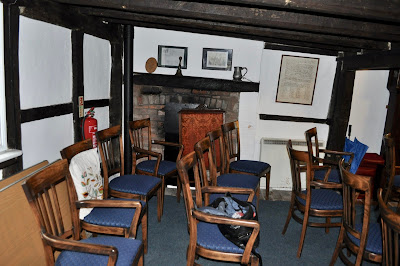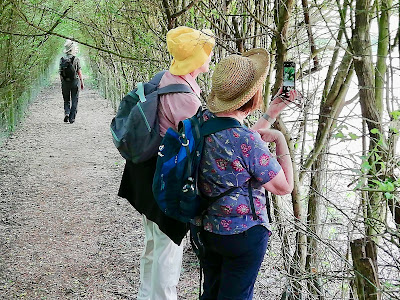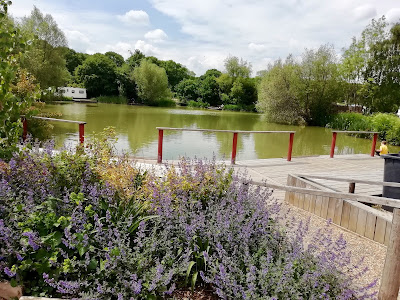Today, with sun hats, sun glasses and sun screen we set off on the second leg of the West Sussex Literary Trail, starting from the pretty village of Slinfold with its former bakery and post office now 're-purposed' to provide private homes.
Incidentally, the pub has changed its name several times over the years. First referenced in 1513, the building was known as Nibletts Farmhouse, before becoming some sort of alehouse run by a landlord, John Penfold, who appears in court records of the 1630s being fined for selling illegal measures! It became The Red Lyon, then The King's Head then reverted to The Red Lyon again!
through the kissing gate
to emerge shortly afterwards in the graveyard of St Nicholas Church, Itchingfield.
Records show that the strange custom of 'skug hunting' (chasing squirrels) on Boxing Day was practised in the woods around Itchingfield well into the 19th century.
We quickly find the grave of David R Francis, a local historian, who wrote many articles for the parish magazine about Itchingfield and the main settlement of Barns Green. Here he is is seen on the right.
Although there has reputedly been a church on this site since 1125 AD, the church was only dedicated to St Nicholas in 1513 and the wooden bell tower, built entirely of oak, is believed to be the only example of its kind in the country. Apparently, because the tower is not attached to the church, when the five bells are rung the tower rocks from side to side!
The 16th C Priest House used to be the cottage where the paid clerical assistant to the priest lived, but its use was extended by 1580 to house the local poor.
Leaving the churchyard, we soon come across the rather sad sight of the old Itchingfield School where one of our walkers once taught. It closed in 2015 after serving the local population for 161 years, but before closure the school children buried a time capsule in the grounds.
Next, we stray only a couple of metres or so from our trail, to visit Julia and Emma's Arboretum and Memorial Garden. This beautiful and poignant site is devoted to the memory of a mother and her young daughter who were tragically killed in South Africa in 1996.
Back on the trail we pass through the gates of Muntham Lodge
and soon encounter Muntham House School.
Down the track we go, through the woods all the while knowing we are now only a stone's throw away from our lunchtime destination in Barns Green.
Time now for our lunch stop at the beautiful Sumners Ponds.
Nearby, at Newbuildings Place, Shipley, lived Wilfred Scawen Blunt (1840-22), author, poet, traveller and breeder of Arab horses. Amongst others, Hilaire Belloc, Oscar Wilde, William Morris, Ezra Pound, John Masefield and Winston Churchill all visited the house. Blunt died here and is buried in the grounds behind the house.
Another well-known resident of Shipley was the poet and writer, Hilaire Belloc (1870-1953). In 1906, he purchased land and a house called King's Land at Shipley where he brought up his family and lived until shortly before his death. More of him further along the trail.
After refuelling, we set off once more heading for the section of the walk that is the 'Low Weald', an area of ponds, streams and copses which in days gone by provided charcoal for local iron and glass industries. We reach the railway crossing just as a train goes whizzing by, thankful that we can enjoy the countryside at a much more leisurely pace!
The air is filled with the sound of birdsong. We encounter a group of llamas
an old weighing machine
and verges dotted with wildflowers and self seeded aquilegia.
Suddenly we emerge onto the busy A272 to Billingshurst and are forced to do a section of road walking before turning off into Old House Lane. In 400 metres we reach today's destination, The Blue Idol.
The oldest part of this building dates from the late 16th century. In 1690 it became the Quaker Meeting House where William Penn (1644-1718), writer, debtor and founder of Pennsylvania, attended regularly, although Warmington 4 miles away, was his home in England for over thirty years.
We are warmly welcomed to this most peaceful site by some Quaker Friends, who kindly offer us cups of tea, for which we are most grateful.
Join us again when we walk next time from The Blue Idol to Cootham!
 |
| Did anybody do a spell check on the pub name? |
Turning down Hayes Lane we quickly pass a small pond and very soon cross over the 'Downs Link' another popular walking route, 37 miles long, linking the North Downs with the South Downs.
 |
| Right to Guildford, left to Bramber |
A short distance from this point along the Downs Link is Christ's Hospital, Bluecoat School which was founded in 1552 by King Edward VI, but which moved to West Sussex in 1902. Its pupils wear a distinctive school uniform said to be the oldest still in existence and 95% of modern pupils voted to continue wearing it.
Past pupils known principally for their literary prowess were Samuel Taylor Coleridge (poet and literary critic), Charles Lamb (essayist), Leigh Hunt (critic, essayist and poet) and Bernard Levin (journalist, author and broadcaster). However, two lesser known 'Old Blues' are worthy of a mention on this 'literary trail'. Firstly, Edmund Blunden (1896 - 1974) was at the school when WW1 began. He enlisted into the Royal Sussex Regiment, fought at Ypres and the Somme where he was awarded the Military Cross, and miraculously lived to tell the tale. Afterwards he became a Fellow and tutor of English at Merton College, Oxford, writing 'war poetry', and biographies of Percy Bysshe Shelley, and the aforementioned past pupils, Charles Lamb and Leigh Hunt. He was nominated for the Nobel Prize for Literature six times and is commemorated in Poets' Corner in Westminster Abbey.
Secondly, Keith Douglas (1920-1944) began writing poetry whilst still at Christ's Hospital School. In 1938 he entered Blunden's old alma mater to study English but when WW2 broke out he enlisted and served as a tank commander in N Africa. He was wounded in the D Day landings 1944 and died three days later, cutting short the full promise of a career as a poet.
Secondly, Keith Douglas (1920-1944) began writing poetry whilst still at Christ's Hospital School. In 1938 he entered Blunden's old alma mater to study English but when WW2 broke out he enlisted and served as a tank commander in N Africa. He was wounded in the D Day landings 1944 and died three days later, cutting short the full promise of a career as a poet.
If we were to walk just a very little way further along the Downs link we would soon reach the village of Southwater where Lintot Square is named after the publisher, Bernard Barnaby Lintot
(1675-1735). He became a bookseller in London then progressed into publishing, authors such as Alexander Pope, John Dryden and John Gay being amongst his customers, and it was Lintot who used illustrations related to text (rather than for decoration alone), for the first time.
Turning off the Downs Link we head through fields where we spy spotted orchids and speckled wood butterflies in abundance, then uphill into woodland, glad of a few minutes' shade.
Soon we are back into open fields bordered by a dog rose hedge
before the footpath leads us through thigh-high fields of waving barley.
Soon we are back into open fields bordered by a dog rose hedge
before the footpath leads us through thigh-high fields of waving barley.
through the kissing gate
to emerge shortly afterwards in the graveyard of St Nicholas Church, Itchingfield.
Records show that the strange custom of 'skug hunting' (chasing squirrels) on Boxing Day was practised in the woods around Itchingfield well into the 19th century.
We quickly find the grave of David R Francis, a local historian, who wrote many articles for the parish magazine about Itchingfield and the main settlement of Barns Green. Here he is is seen on the right.
Although there has reputedly been a church on this site since 1125 AD, the church was only dedicated to St Nicholas in 1513 and the wooden bell tower, built entirely of oak, is believed to be the only example of its kind in the country. Apparently, because the tower is not attached to the church, when the five bells are rung the tower rocks from side to side!
 |
| The 14th C timber belfry tower built without nails, was renovated in the 1860s |
 |
| Church of St Nicholas, Itchingfield |
The 16th C Priest House used to be the cottage where the paid clerical assistant to the priest lived, but its use was extended by 1580 to house the local poor.
 |
| The Priest House |
Leaving the churchyard, we soon come across the rather sad sight of the old Itchingfield School where one of our walkers once taught. It closed in 2015 after serving the local population for 161 years, but before closure the school children buried a time capsule in the grounds.
 |
| Ripe for development? |
 |
| Beautiful blue iris |
Back on the trail we pass through the gates of Muntham Lodge
and soon encounter Muntham House School.
 |
| Muntham House School |
Time now for our lunch stop at the beautiful Sumners Ponds.
Another well-known resident of Shipley was the poet and writer, Hilaire Belloc (1870-1953). In 1906, he purchased land and a house called King's Land at Shipley where he brought up his family and lived until shortly before his death. More of him further along the trail.
After refuelling, we set off once more heading for the section of the walk that is the 'Low Weald', an area of ponds, streams and copses which in days gone by provided charcoal for local iron and glass industries. We reach the railway crossing just as a train goes whizzing by, thankful that we can enjoy the countryside at a much more leisurely pace!
an old weighing machine
and verges dotted with wildflowers and self seeded aquilegia.
Suddenly we emerge onto the busy A272 to Billingshurst and are forced to do a section of road walking before turning off into Old House Lane. In 400 metres we reach today's destination, The Blue Idol.
The oldest part of this building dates from the late 16th century. In 1690 it became the Quaker Meeting House where William Penn (1644-1718), writer, debtor and founder of Pennsylvania, attended regularly, although Warmington 4 miles away, was his home in England for over thirty years.
 |
| The Quaker man was at one time identified as William Penn |
 |
| Interior of the Meeting House |
 |
| Relaxing with a cuppa at the end of our walk |
We are warmly welcomed to this most peaceful site by some Quaker Friends, who kindly offer us cups of tea, for which we are most grateful.
Join us again when we walk next time from The Blue Idol to Cootham!





























No comments:
Post a Comment